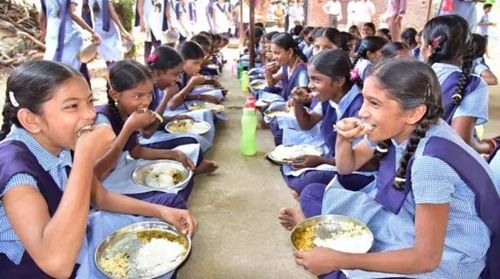The Indian government is doing a really great thing whereby free meals are distributed to children at government and government-funded institutions all across the country. Initiated in 1995, this program aims to improve the health and educational performance of young people from six to fourteen, you know?
What is therefore on the menu? a regular intake of wholesome foods capable of more than merely providing for hunger, that’s what! We are discussing fighting malnutrition so that kids only concentrate on their schoolwork free from a grumbling stomach. Furthermore, it’s a great approach to convince parents to keep their children in the classroom, after all, who wouldn’t want their child to receive a free, delicious dinner every school day? But like any large-scale initiative, this scheme has its own set of advantages and disadvantages.

Advantages of the Mid Day Meal Scheme
1. Boosts School Enrollment
You see, the Mid Day Meal Program is revolutionary for education, not only for satisfying hunger. As you can already guess, giving free meals attracts children from poor families and gives them a meaningful incentive to study for the long term so they don’t drop out at an early age. Parents considering school for their children would naturally combine a good meal with the opportunity to study. This smart action guarantees that hunger never stops a youngster from school, therefore opening the path for better futures all around.
2. A Fight Against Malnutrition
The Mid Day Meal Scheme performs kinda a hero’s service in areas where empty plates are more prevalent than full ones. It dishes meals loaded with nutrients youngsters need to grow up clever and healthy. Zeroing in on what young bodies require guarantees that every meal is more than simply food, it’s fuel, you know?
3. Empowers Women, But How?
Imagine using one stone to kill two birds! The Mid Day Meal Scheme employs local women as chefs and assistants, therefore empowering them rather than only feeding children. More than money, this employment opportunity gives women a boost in self-esteem and lets them feel as though they are changing things for the community. This empowerment uplifts all those engaged and spreads waves of good change across homes and businesses.
4. Levels the Playing Field
The Mid Day Meal Scheme is helping to remove divisions formed by society in a society where everyone is meant to have a fair opportunity. Quite literally, it gathers children from various walks of life to the same table, therefore helping to eliminate prejudices and create bridges. We know it sounds cliche but sure, this program is like a melting pot, when everyone eats together, distinctions vanish and an early age of equality and unity is fostered.
5. Gets the Community on Board
The Mid Day Meal Scheme lives on communal spirit. It is not a one-man show. How? Everybody is participating, from kitchen tables to nearby fields. This strategy supports the local economy in addition to providing better, regionally specialized cuisine. And let’s not overlook that with everyone contributing, the entire process becomes more open and responsible, ensuring every rupee and every grain counts.
Disadvantages of the Mid Day Meal Scheme
1. Quality Control Issues
Would you find it surprising that although the Mid Day Meal Scheme provides meals to millions of students in the schools and maintains top-notch standards everywhere, not all the time, it is super easy to make it keep going like that? We’re talking about making sure every meal is hygienic, healthy, and just good to eat, which occasionally just doesn’t happen. Sometimes the food that is presented isn’t quite what you would call five-star, nutritionally speaking, or maybe even cause you to consider cleanliness twice-through.
2. Logistical Challenges
Imagine having to supply food across large distances including some really isolated areas, and that’s precisely what presents a logistical challenge! Ensuring that every school receives food on schedule, in the correct quantity, and in edible condition is a HUGE task. These difficulties might affect the meal times and people’s level of confidence in this very scheme. What’s the solution though? Well, maintaining the seamless operation of the food train depends absolutely on creative solutions and robust system building.
3. Dependency Issues
Indeed, for many people the Mid Day Meal Scheme is a lifeline, but here’s the twist: it can cause others to rely perhaps too much on handouts. Some groups may be prevented from economically standing on their own two feet by this very reliance. The simple availability of free meals might slow down families’ advancement toward becoming self-sufficient, not help them to improve their financial game.
4. Budget Issues
Let’s talk money, the Mid Day Meal Scheme cannot fully run without enough of it. The quality or quantity of the meals may suffer when the money is limited, or the general program reach may not be as strong as it could be. Maintaining the effectiveness of the program and extending its reach to even more hungry mouths depends on ensuring adequate funds in the budget.
5. Difficulties In Implementation
Implementing the Mid Day Meal Scheme nationwide is sure as difficult as it sounds. It is not easy to get several government departments, NGOs, and local people to march at the same pace. Sometimes your mismanagement, red tape, and even corruption in the system cause problems. Real change will involve a strong effort to streamline procedures, increase responsibility, and ensure that the assistance reaches those most in need without delay.
Quick Advantages and Disadvantages of Mid-Day Meal Scheme
| Advantages | Disadvantages |
| Encourages enrollment and reduces dropout rates by providing free meals | Challenges in maintaining hygiene and nutritional standards |
| Provides nutritious meals essential for children’s growth | Logistical issues in delivering food to remote areas |
| Employs women as cooks, boosting their self-esteem and community involvement | May lead to over-reliance on free meals, hindering economic self-sufficiency |
| Brings children from different backgrounds together, reducing social barriers | Budget limitations can affect meal quality and program reach |
| Involves local communities, supporting the local economy and ensuring transparency | Coordination issues among various stakeholders can cause delays and inefficiencies |



